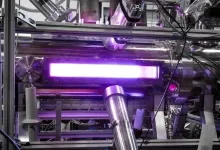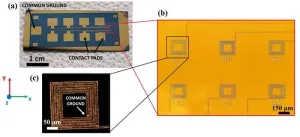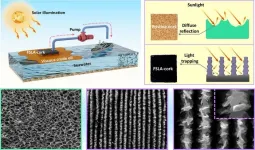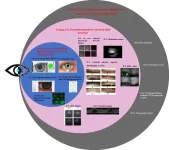(Press-News.org) In the nine decades since humans first produced fusion reactions, only a few fusion technologies have demonstrated the ability to make a thermal fusion plasma with electron temperatures hotter than 10 million degrees Celsius, roughly the temperature of the core of the sun. Zap Energy’s unique approach, known as a sheared-flow-stabilized Z pinch, has now joined those rarefied ranks, far exceeding this plasma temperature milestone in a device that is a fraction of the scale of other fusion systems.
A new research paper, published this month in Physical Review Letters, details measurements made on Zap Energy’s Fusion Z-pinch Experiment (FuZE) of 1-3 keV plasma electron temperatures — roughly the equivalent of 11 to 37 million degrees Celsius (20 to 66 million degrees Fahrenheit). Due to the electrons’ ability to rapidly cool a plasma, this feat is a key hurdle for fusion systems and FuZE is the simplest, smallest and lowest cost device to have achieved it. Zap’s technology offers the potential for a much shorter and more practical path to a commercial product capable of producing abundant, on-demand, carbon-free energy to the globe.
“These are meticulous, unequivocal measurements, yet made on a device of incredibly modest scale by traditional fusion standards,” describes Ben Levitt, VP of R&D at Zap. “We’ve still got a lot of work ahead of us, but our performance to date has advanced to a point that we can now stand shoulder to shoulder with some of the world’s pre-eminent fusion devices, but with great efficiency, and at a fraction of the complexity and cost.”
FuZE was originally funded for research at the University of Washington by the U.S. Department of Energy’s Advanced Research Projects Agency – Energy (ARPA-E). The device moved to Zap Energy’s dedicated R&D facilities in 2020, soon after the company was founded. The results in this paper were collected in 2022 in an ARPA-E funded collaboration with researchers from Lawrence Livermore National Laboratory (LLNL) and University of California, San Diego (UCSD), who spearheaded the development of the measurement system used for these results.
“Over many decades of controlled-fusion research, only a handful of fusion concepts have reached 1-keV electron temperature,” notes Scott Hsu Lead Fusion Coordinator at the DOE and former ARPA-E Program Director. “What this team has achieved here is remarkable and reinforces ARPA-E’s efforts to accelerate the development of commercial fusion energy.”
Hot soup
The first step to create the conditions for fusion is to generate a plasma – the energetic “fourth state of matter” where nuclei and electrons aren’t bound together into atoms but flow freely in a sub-atomic soup. Compressing and heating a plasma made of two forms of hydrogen called deuterium and tritium causes their nuclei to collide and fuse. When they do, fusion reactions give off roughly 10 million times more energy per ounce than burning the same amount of coal.
Such fusion reactions have been observed in the lab for decades in relatively small quantities. However, the great challenge is to create more output fusion energy from those reactions than the input energy required to initiate them.
Zap Energy’s technology is based on a simple plasma confinement scheme known as a Z pinch, where large electric currents are channeled through a thin filament of plasma. The conducting plasma generates its own electromagnetic fields, which both heats and compresses it. While Z-pinch fusion has been experimented with since the 1950’s, the approach has largely been stymied by how short-lived its plasmas are, a problem Zap has solved by applying a dynamic flow through the plasma, a process called sheared-flow stabilization.
“The dynamics are a wonderful balancing act of plasma physics,” explains Levitt. “As we climb to higher and higher plasma currents, we optimize the sweet spot where the temperature, density and lifetime of the Z pinch align to form a stable, high-performance fusing plasma.”
A healthy pinch
Fusion researchers measure plasma temperatures in units of electron-volts and can measure the temperature of the plasma’s ions (nuclei) and electrons separately. Since the ions are more than a thousand-fold heavier than the electrons, the two components of the plasma can heat and cool at different rates. Since the ions are what ultimately need to be heated to fusion temperatures, plasma physicists often worry about situations where cold electrons limit ion heating, like ice cubes in a hot soup. The electrons in the FuZE plasma, however, were shown to be as hot as the ions, indicating that the plasma is in a healthy thermal equilibrium.
Further, Zap’s detailed measurements show that electron temperatures and fusion neutron production peak simultaneously. As neutrons are a primary product of the fusing ions, these observations support the idea of a fusing plasma in thermal equilibrium.
“The results in this paper and further tests we’ve done since, all paint a good overall picture of a fusion plasma with room to scale toward energy gain,” says Uri Shumlak, co-founder and Chief Scientist at Zap Energy. “Working at higher currents we’re still seeing sheared flow extending the Z-pinch lifetimes long enough to produce very high temperatures and the associated neutron yields we’d predict from modeling.”
Gold standard measurements
The temperatures reported in the paper were measured by a team of outside collaborators from LLNL and UCSD skilled in a plasma measurement technique called Thomson scattering. To perform Thomson scattering, scientists use a very bright, very fast laser to fire a pulse of green light into the plasma, which scatters off of the electrons and provides information about their temperature and density.
“We’re especially grateful to the collaboration team for the work they did to help gather this data and refine a critical measurement technique for us,” notes Levitt. Informed by this collaboration’s measurements on hundreds of plasmas, Zap now routinely gathers Thomson scattering data on FuZE-Q, its latest-generation device.
No external magnets, compression or heating
Unlike the two mainstream fusion approaches that have been the focus of the majority of fusion research in recent decades, Zap’s technology does not require expensive and complex superconducting magnets or powerful lasers. “Zap tech is orders of magnitude less expensive and quicker to build than other devices, allowing us to iterate rapidly and produce the cheapest thermal fusion neutrons out there. Compelling innovation economics are vital to launching a commercial fusion product on a timescale that matters,” said Benj Conway, CEO and co-founder of Zap.
In 2022, the same time these results from FuZE were collected, Zap commissioned its next-generation device FuZE-Q. While early results from FuZE-Q are still forthcoming, the device has a power bank with ten times the stored energy as FuZE and capacity to scale to much higher temperatures and densities. Meanwhile, parallel development of power plant systems is also underway.
“We started Zap knowing we had a technology that was unique and outside the status quo, so definitively crossing this high electron temperature mark and seeing these results in a premier physics journal is major validation,” says Conway. “We’ve certainly got big challenges ahead, but we have all the ingredients to solve them.”
About Zap Energy
Zap Energy is building a low-cost, compact and scalable fusion energy platform that confines and compresses plasma without the need for expensive and complex magnetic coils. Zap’s sheared-flow-stabilized Z-pinch technology provides compelling fusion economics and requires orders of magnitude less capital than conventional approaches. Zap Energy has over one hundred team members in two facilities near Seattle and is backed by leading financial and strategic investors. Visit Zap online at zapenergy.com.
END
Zap Energy achieves 37-million-degree temperatures in a compact device
New publication reports record electron temperatures for a small-scale, sheared-flow-stabilized Z-pinch fusion device.
2024-04-23
ELSE PRESS RELEASES FROM THIS DATE:
Magnetic microcoils unlock targeted single-neuron therapies for neurodegenerative disorders
2024-04-23
WASHINGTON, April 23, 2024 — Neural stimulation is a medical technique used to treat many illnesses affecting the nervous system. It involves applying energy to neurons to encourage them to grow and make connections with their neighbors. Treatments for epilepsy can often include neural stimulation, and similar treatments exist for Parkinson’s disease, chronic pain, and some psychiatric illnesses.
In the Journal of Vacuum Science & Technology A, by AIP Publishing, researchers from the University of Minnesota deployed an array of microscopic coils — microcoils — to create ...
Laser-treated cork absorbs oil for carbon-neutral ocean cleanup
2024-04-23
WASHINGTON, April 23, 2024 – Oil spills are deadly disasters for ocean ecosystems. They can have lasting impacts on fish and marine mammals for decades and wreak havoc on coastal forests, coral reefs, and the surrounding land. Chemical dispersants are often used to break down oil, but they often increase toxicity in the process.
In Applied Physics Letters, by AIP Publishing, researchers from Central South University, Huazhong University of Science and Technology, and Ben-Gurion University of the Negev used laser treatments to transform ordinary ...
COVID-19 vaccination and incidence of pediatric SARS-CoV-2 infection and hospitalization
2024-04-23
About The Study: The findings of this study including 3.9 million children suggest that vaccination against SARS-CoV-2 was associated with significant reductions in COVID-19 incidence and hospitalizations among children in California.
Authors: Justin V. Remais, Ph.D., of the University of California, Berkeley, is the corresponding author.
To access the embargoed study: Visit our For The Media website at this link https://media.jamanetwork.com/
(doi:10.1001/jamanetworkopen.2024.7822)
Editor’s Note: Please see the article for additional information, including other authors, author contributions and affiliations, conflict of interest and ...
Long-term taste and smell outcomes after COVID-19
2024-04-23
About The Study: Taste dysfunction as measured objectively was absent one year after exposure to COVID-19 while some smell loss remained in nearly one-third of individuals with this exposure, likely explaining taste complaints of many individuals with post–COVID-19 condition in this study of 340 individuals with and 434 individuals without prior COVID-19. Infection with earlier untyped and Alpha variants was associated with the greatest degree of smell loss.
Authors: Shima T. Moein, M.D., Ph.D., of the University of Pennsylvania ...
Artificial intelligence to be used for the detection of common eye disease
2024-04-23
Dry Eye Disease (DED) is one of the more common eye diseases, affecting up to 30% of the world’s population. This disease can affect many different types of people and can wind up being a great hindrance to their overall quality of life. Early screening and prognosis is vital to the patient’s progression with the disease. However, this can be difficult. In this study, researchers aim to use artificial intelligence (AI) to aid in early screening and prognosis of DED. Not only can the use of AI make screening more accessible for ...
A roadmap for digital neuroscience
2024-04-23
Neuroscience has entered a new, digital phase. The combination of brain research with supercomputing in large-scale, multi-disciplinary research collaborations has enabled an innovative approach to deciphering the brain, using powerful scientific technologies and data ressources. These developments open up new possibilities for brain research, medicine and technology. A position paper by over 100 authors, now published in the journal Imaging Neuroscience, summarises the current status and identifies ...
Radiologists propose actions to combat climate change
2024-04-23
OAK BROOK, Ill. – A diverse writing group—lead by authors at the University of Toronto—have developed an approach for radiology departments and practices to reduce their greenhouse gas emissions and become more resilient to the effects of climate change. They outlined their action plan in a Radiology in Focus article, published today in Radiology, a journal of the Radiological Society of North America (RSNA).
“Rising greenhouse gas emission levels lead to climate change, extreme weather events and worsening air pollution with downstream adverse health effects,” said lead author Kate Hanneman, M.D., M.P.H., vice chair of research ...
SwRI to discuss connected vehicle data exchanges, AI tools at 2024 ITS America Conference & Expo
2024-04-23
SAN ANTONIO — April 23, 2024 — During this week’s ITS America Conference & Expo, Southwest Research Institute will share its latest intelligent transportation systems (ITS) research designed to integrate connected vehicle data exchanges and artificial intelligence into public transportation infrastructure.
“SwRI’s ITS solutions are designed to improve safety for the traveling public using software that helps transportation agencies operate more efficiently,” said Josh Johnson, ...
Announcing the second cohort of the Hevolution/AFAR new investigator awardees in aging biology and geroscience research
2024-04-23
New York, NY —The American Federation for Aging Research (AFAR) is pleased to announce the second cohort of the Hevolution/AFAR New Investigator Awards in Aging Biology and Geroscience Research, a grant program to enable early-career investigators with labs in the US and Canada to advance research projects in basic biology of aging, as well as geroscience projects that translate advances in basic research on aging biology from the laboratory to the clinic, paving the way for healthspan-expanding therapeutics and treatments. ...
Advances in understanding the evolution of stomach loss in agastric fishes
2024-04-23
Living beings can evolve to lose biological structures due to potential survival benefits from such losses. For example, certain groups of ray-finned fishes show such regressive evolution—medakas, minnows, puffera, and wrasses do not have a stomach in the gastrointestinal tract, making them agastric or stomachless fishes. However, the specific evolutionary mechanisms underlying the evolution of agastric fishes remains unclear.
Studies about Slc26a9—a molecular transporter highly expressed in the stomach of many species—in fishes provided the initial clue. Researchers ...
LAST 30 PRESS RELEASES:
Tracing the quick synthesis of an industrially important catalyst
New software sheds light on cancer’s hidden genetic networks
UT Health San Antonio awarded $3 million in CPRIT grants to bolster cancer research and prevention efforts in South Texas
Third symposium spotlights global challenge of new contaminants in China’s fight against pollution
From straw to soil harmony: International team reveals how biochar supercharges carbon-smart farming
Myeloma: How AI is redrawing the map of cancer care
Manhattan E. Charurat, Ph.D., MHS invested as the Homer and Martha Gudelsky Distinguished Professor in Medicine at the University of Maryland School of Medicine
Insilico Medicine’s Pharma.AI Q4 Winter Launch Recap: Revolutionizing drug discovery with cutting-edge AI innovations, accelerating the path to pharmaceutical superintelligence
Nanoplastics have diet-dependent impacts on digestive system health
Brain neuron death occurs throughout life and increases with age, a natural human protein drug may halt neuron death in Alzheimer’s disease
SPIE and CLP announce the recipients of the 2025 Advanced Photonics Young Innovator Award
Lessons from the Caldor Fire’s Christmas Valley ‘Miracle’
Ant societies rose by trading individual protection for collective power
Research reveals how ancient viral DNA shapes early embryonic development
A molecular gatekeeper that controls protein synthesis
New ‘cloaking device’ concept to shield sensitive tech from magnetic fields
Researchers show impact of mountain building and climate change on alpine biodiversity
Study models the transition from Neanderthals to modern humans in Europe
University of Phoenix College of Doctoral Studies releases white paper on AI-driven skilling to reduce burnout and restore worker autonomy
AIs fail at the game of visual “telephone”
The levers for a sustainable food system
Potential changes in US homelessness by ending federal support for housing first programs
Vulnerability of large language models to prompt injection when providing medical advice
Researchers develop new system for high-energy-density, long-life, multi-electron transfer bromine-based flow batteries
Ending federal support for housing first programs could increase U.S. homelessness by 5% in one year, new JAMA study finds
New research uncovers molecular ‘safety switch’ shielding cancers from immune attack
Bacteria resisting viral infection can still sink carbon to ocean floor
Younger biological age may increase depression risk in older women during COVID-19
Bharat Innovates 2026 National Basecamp Showcases India’s Most Promising Deep-Tech Ventures
Here’s what determines whether your income level rises or falls
[Press-News.org] Zap Energy achieves 37-million-degree temperatures in a compact deviceNew publication reports record electron temperatures for a small-scale, sheared-flow-stabilized Z-pinch fusion device.









